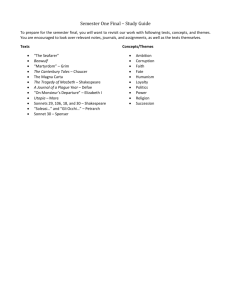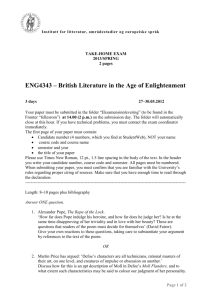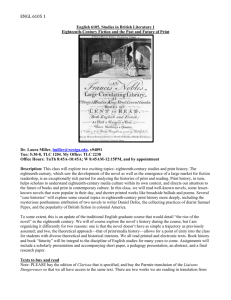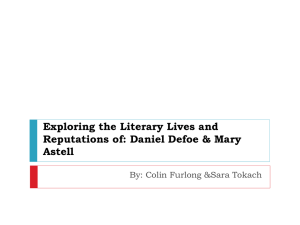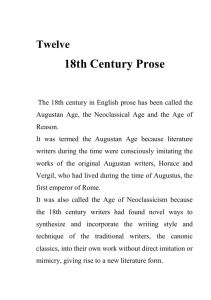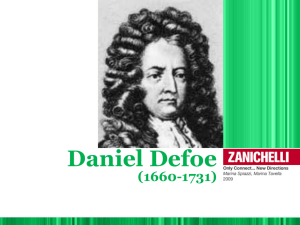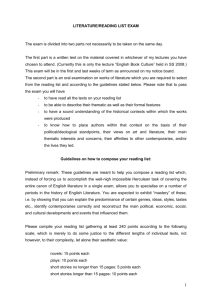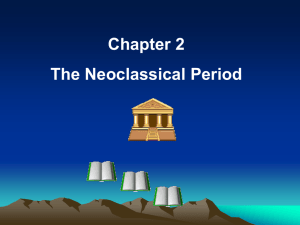Digital Natives or Digital Strangers? Teaching the Eighteenth
advertisement
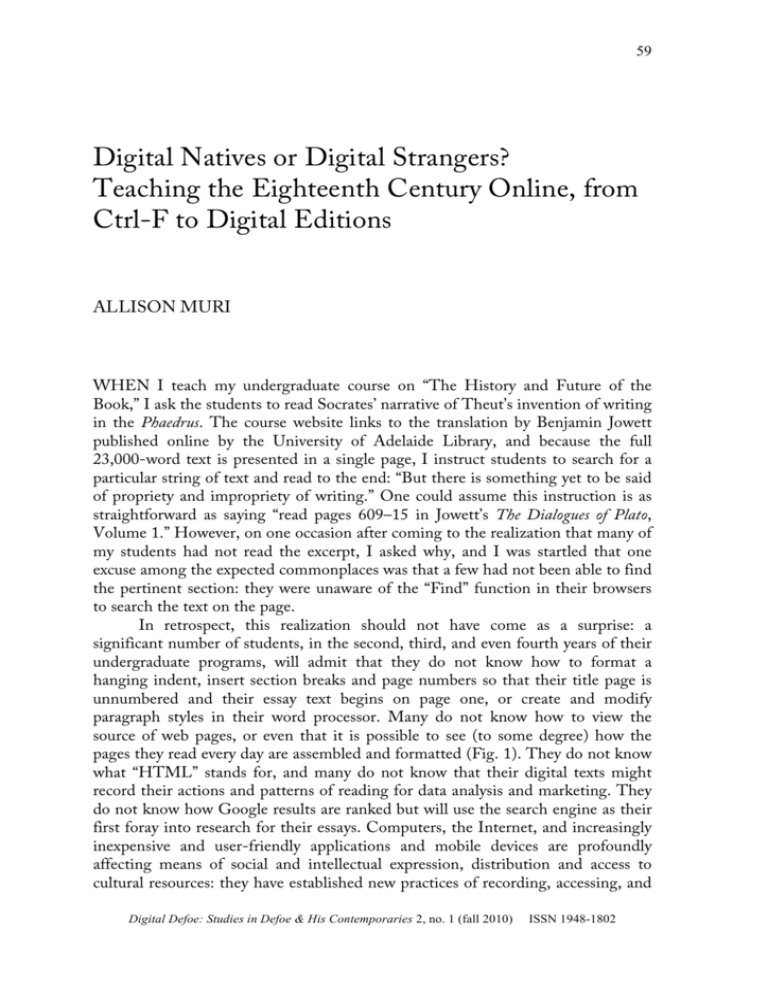
59 Digital Natives or Digital Strangers? Teaching the Eighteenth Century Online, from Ctrl-F to Digital Editions ALLISON MURI WHEN I teach my undergraduate course on “The History and Future of the Book,” I ask the students to read Socrates’ narrative of Theut’s invention of writing in the Phaedrus. The course website links to the translation by Benjamin Jowett published online by the University of Adelaide Library, and because the full 23,000-word text is presented in a single page, I instruct students to search for a particular string of text and read to the end: “But there is something yet to be said of propriety and impropriety of writing.” One could assume this instruction is as straightforward as saying “read pages 609–15 in Jowett’s The Dialogues of Plato, Volume 1.” However, on one occasion after coming to the realization that many of my students had not read the excerpt, I asked why, and I was startled that one excuse among the expected commonplaces was that a few had not been able to find the pertinent section: they were unaware of the “Find” function in their browsers to search the text on the page. In retrospect, this realization should not have come as a surprise: a significant number of students, in the second, third, and even fourth years of their undergraduate programs, will admit that they do not know how to format a hanging indent, insert section breaks and page numbers so that their title page is unnumbered and their essay text begins on page one, or create and modify paragraph styles in their word processor. Many do not know how to view the source of web pages, or even that it is possible to see (to some degree) how the pages they read every day are assembled and formatted (Fig. 1). They do not know what “HTML” stands for, and many do not know that their digital texts might record their actions and patterns of reading for data analysis and marketing. They do not know how Google results are ranked but will use the search engine as their first foray into research for their essays. Computers, the Internet, and increasingly inexpensive and user-friendly applications and mobile devices are profoundly affecting means of social and intellectual expression, distribution and access to cultural resources: they have established new practices of recording, accessing, and Digital Defoe: Studies in Defoe & His Contemporaries 2, no. 1 (fall 2010) ISSN 1948-1802 60 manipulating information, and they have resulted in new forms of literary and cultural expression such as e-books, wikis, blogs, feeds, scholarly TEI-compliant texts, databases, mashups, apps, and games. And yet significant numbers of our students understand little about how the texts they are reading and writing every day actually work, have limited technical skills to manipulate them, and know surprisingly little in general about the cultural implications of digital texts. Fig 1. The “View source” tool in Firefox. Phaedrus, distributed by eBooks@Adelaide (the University of Adelaide Library), is licensed for use under Creative Commons Attribution-NonCommercial-ShareAlike 2.5 Australia. My examples are anecdotal but would seem to confirm the conclusions of various reports on and studies of so-called “digital natives” in recent years. Robert Kvavik observes, in his study of 4,374 undergraduate students in the United States: Our quantitative data show that, in general, students say they have the skills they need. The qualitative data suggest a slightly different picture. Students have very basic office suite skills as well as e-mail and basic Web surfing skills. Moving beyond basic activities is problematic. It appears that they do not recognize the enhanced functionality of the applications they own and use. (7.7) Similarly, the findings of an Australian study of 2,588 first-year students by Gregor Kennedy et al. found that while the majority “use a computer at least once per month to manage or manipulate digital photos and to play digital audio files,” the use of more sophisticated software, “such as audio and video editing or . . . Photoshop is much less common” (Kennedy et al. 520). Furthermore, while basic activities “such as searching for information on the web, email, mobile telephony and SMS messaging are used very frequently by a large majority,” newer technologies “that allow students to collaborate and to produce and publish material online are used by a relatively small proportion” (522). Digital Defoe: Studies in Defoe & His Contemporaries 2, no. 1 (fall 2010) ISSN 1948-1802 61 Meanwhile, textual scholar Jerome McGann is calling for the desegregation of digital research and undergraduate education: For many years the approach we took at IATH -- we were typical -- made sense: to promote specific projects in digital scholarship outside the traditional departmental and institutional structures of the research university. It seems obvious now that we need to integrate our scholarship into the programmatic heart of the university, and specifically into our courses and with our students, undergrads as well as grads. Humanities scholarship needs those people, and most of all it needs to work with them in the world of their degree programs, and not along the marches of that world. . . . we need them because the future of humanities scholarship, exposing what Michael Keller calls the ‘big ideas,’ often comes from that population of young people. (x) As educators, we need to encourage our students to defy the popular notion that online reading actually diminishes human intelligence, as suggested by Nicholas Carr, who writes that “What the Net diminishes is . . . the ability to know, in depth, a subject for ourselves, to construct within our own minds the rich and idiosyncratic set of connections that give rise to a singular intelligence” (143). We need our students to engage with Carr’s assumption that while writing “on a page of parchment or paper enabled us to become deep readers, to turn our attention, and our brain power, to the interpretation of meaning,” with “writing on the screen . . . we’re no longer guided toward a deep, personally constructed understanding of the text’s connotations” (166). Our students need the technical expertise and the technical literacy to counter the claim that “screen intelligence doesn’t transfer well to non-screen experiences, especially the kinds that build knowledge and verbal skills,” as Mark Bauerlein argues, suggesting that reading online conditions minds against quiet, concerted study, against imagination unassisted by visuals, against linear, sequential analysis of texts. . . .Visual culture improves the abstract spatialization and problem solving, but it doesn’t complement other intelligence-building activities. Smartness here parallels dumbness elsewhere. The relationship between screens and books isn’t benign. (95) If we were to accept these conclusions -- even if we do not (and I do not) -addressing the stereotypes bears some attention from our education system. The mass digitization of books, the growth of digital collections, and the ubiquity of digital texts suggest that the roles of educators in the humanities need to change. Before we can successfully incorporate our scholarship, digital or otherwise, into the undergraduate classroom, however, we are obliged to teach students how to find, sort, assemble, and read these texts. My reader will surely be asking by now, “But what has all this to do with teaching the Eighteenth Century online?” I am suggesting that teaching the period online is only in part a matter of introducing our students to the many outstanding eighteenth-century resources available online today.1 It is also a matter of Digital Defoe: Studies in Defoe & His Contemporaries 2, no. 1 (fall 2010) ISSN 1948-1802 62 providing them with the technical and critical skills necessary to understand, participate in, analyze, appraise, evaluate, influence, and create the texts and technologies, both scholarly and popular, that are currently in use and surely will continue to develop throughout their lifetimes. For these reasons I have required students to submit their work and discuss them on blogs, and I have asked students to edit wikis. I have taught them basic techniques for searching databases, and I have introduced them to HyperText Markup Language (HTML) and Cascading Style Sheets (CSS) so they can create their own online editions. Admittedly, these exercises have some potential complications: for example, one belligerent or aggressive blogger can stifle the expressivity of the majority of participants in a class, and the investment of time and energy to set up, monitor, and mark an evolving set of digital communications is not insignificant. Yet, I believe, the benefits far outweigh the potential conflicts and time pressures. What follows are some examples of how I approach teaching seventeenth- and eighteenth-century works in the context of digital resources and the study of new media. SEARCHING, DATABASES, FIELDS, AND CATEGORIES If “the Googlization of everything” (Vaidhyanathan n.p.) is upon us, my goal is to teach students to actively seek to understand how the texts they read are assembled and to exert some control in creating the pages they most want to read rather than to passively accept the database’s attempt to interpret keyword or natural language searching. Google’s excellence in this regard tends to foster certain misunderstandings when inexperienced users search scholarly databases with different interfaces and different means of determining authority and relevance. Google bases keyword search results on the frequency of those keywords on a given page, as well as on the length of time the page has existed and the number and quality of links to the page. It also ranks web pages based on the anchor text used to link to them, so the keywords do not even have to appear on the page that comes up in the search results. More than two hundred signals help the search engine to find what readers are looking for, based on contextual information: the algorithm is designed to distinguish between place names and the names of people, for example. Google’s algorithm also uses synonyms for keywords to expand relevant results and to provide alternatives for misspelled words (Levy; Google; googleblog). The power of popular language usage and page popularity are key to Google’s pursuit of the “perfect search engine,” defined by co-founder Larry Page as one that “understands exactly what you mean and gives you back exactly what you want” (Google). Google does not, as professors habitually warn their students, determine if the information on the page is researched, peer reviewed, or thoroughly the invention of a delusional mind; however, it does, almost magically, “understand” what information is being requested. If I type “meaning of innocence and experience” into a Google form, William Blake and his works dominate the Digital Defoe: Studies in Defoe & His Contemporaries 2, no. 1 (fall 2010) ISSN 1948-1802 63 first page of results, but these include SparkNotes, a MySpace page of musical recordings inspired by Blake, and 123helpme.com; the same term in EBSCO’s MLA International Bibliography results in scholarly articles but the first page lists works on John Milton, William Blake, Benito Cereno, the Naudet brothers, Octavio Paz, Charles Dickens, Elizabeth Bowen, Andrew Marvell, Jean Paul Sartre, and Albert Camus. I need hardly note that students already know how to conduct research using Google, and some are very effective at searching and evaluating the results. As De Rosa et al. found in 2005, “89 percent of college student information searches begin with a search engine,” while library websites “were selected by just 2 percent of students as the source used to begin an information search” (De Rosa et al. 1-7). Sixty-eight percent reported Google was the search engine they used most recently, while Yahoo! was used by 15 percent and MSN Search by 5 percent (18). However, corroborating what I see in second- and third-year students’ essays, their evaluations of relevance and authority of the results are often naive or desultory. According to this report, “More than half of college students (53 percent) believe information from search engines is at the same level of trustworthiness as library information” (3-4). In my experience, students do not know that Google’s PageRank algorithm incorporates “votes” -- that is, the number of incoming links from other trusted sites -- to help determine how useful any results will be for a given search term. Usually this system works very effectively and Google is, of course, a valuable and beneficial tool, but the fact that the library’s scholarly databases are largely foreign territory for undergraduates is a concern. Even when introduced to these resources, the relatively undifferentiated display of results in some databases can lead inexperienced users to assume that the MA thesis or newspaper article they have found is equivalent to a peer-reviewed publication. Even experienced students can have difficulty deciphering whether they are searching only titles and abstracts, or also full-text articles, and thus how best to frame their search terms. A significant number of students assume that search engines can interpret questions and phrases as natural language (one student noted in frustration that the MLA Bibliography database found no results for a search on “Blake” AND "significance of illumination" OR "meaning of illumination"): frequently they find using the library databases difficult and intimidating. While most students know how to search for a specific phrase by placing the words in quotation marks, other limiters such as Boolean operators, wildcards, proximity searches, and so on are frequently unfamiliar and poorly understood. Accordingly, in an admittedly artificial exercise, I ask my students to create complex search terms in library databases using these operators as creatively as they can to generate sets of results that might provide answers to a given research question (See Online Research Project). To introduce them to Boolean searching, I show my students how to narrow a large set of results from a broad keyword search down to a more manageable set. The library’s catalogue interface works well, or for students in eighteenth-century studies, the Eighteenth-Century Digital Defoe: Studies in Defoe & His Contemporaries 2, no. 1 (fall 2010) ISSN 1948-1802 64 Collections Online (ECCO) database interface proves especially effective since we can conduct both author-title field searching of records and full-text searching of works. For example, searching for “Alexander Pope” as keywords in ECCO results in 1065 hits. The difference between keyword searching and field searching is immediately obvious (in ECCO, the term “Alexander Pope” is searched as “Alexander n4 Pope” and thus the results include such works as The Ancient and Present State of Glocestershire by Sir Robert Atkyns the Younger, the full text of which contains the words “Pope Alexander”). Searching for “Alexander Pope” in the author field narrows results to 853 (Fig. 2). Fig 2. Results of a search for the words Alexander Pope in the author field in ECCO.. Used with permission from Eighteenth Century Collections Online (ECCO) from Gale, a part of Cengage Learning. The first eight of these are Letters of Abelard and Heloise by Peter Abelard. Students will readily enough determine why this is so: the title of each also includes variations on “To which is added” or “Together with” “The Poem of Eloisa to Abelard By Mr. Pope.” I ask: What if you wanted to exclude the poem from the resulting set? While students may not recognize the word “Boolean,” they usually know that dropdown menus containing these operators can filter the results further, for example, by specifying “NOT Abelard” in the title field (Fig 3). The result set for the second search is 830 texts. Scrolling down, we can see that several pages of results are comprised of translations of The Iliad and Odyssey of Homer and The Iliad of Homer: if we were more interested in Pope’s original works than his translations, how would we further exclude these titles? Students will suggest excluding Homer from the title field as well, but when I ask them whether we use AND, OR or NOT in the next dropdown, they often suggest OR, a reasonable Digital Defoe: Studies in Defoe & His Contemporaries 2, no. 1 (fall 2010) ISSN 1948-1802 65 assumption since in natural language expression we might say “Alexander Pope but not Abelard or Homer” (Fig 4). Fig. 3. Boolean search for Alexander Pope NOT Abelard [in title] on ECCO’s Advanced Search page. Used with permission from Eighteenth Century Collections Online (ECCO) from Gale, a part of Cengage Learning. Fig. 4. Boolean search for Alexander Pope NOT Abelard [in title] OR Homer [in title] in ECCO’s Advanced Search page. Used with permission from Eighteenth Century Collections Online (ECCO) from Gale, a part of Cengage Learning. Digital Defoe: Studies in Defoe & His Contemporaries 2, no. 1 (fall 2010) ISSN 1948-1802 66 However, when we try this term (Fig 4) the result set is 1007 -- higher than the original search for Pope as author. I ask the students to determine the reason for this result (that is, when using these menus the search engine applies the terms in the order they appear). The search in Fig 4 is equivalent to: (all works in the database where the author field contains Alexander within 4 words of Pope and the title field does not contain Abelard) OR (all works in the database where the title field contains Homer) Accordingly the results include works such as Proofs of the Enquiry into Homer’s Life and Writings, Translated into English by Thomas Blackwell. The alternative “NOT Homer” results in a much smaller set of 645 results (Fig 5): Fig. 5. Boolean search for Alexander Pope NOT Abelard [in title] NOT Homer [in title] in ECCO’s Advanced Search page. Used with permission from Eighteenth Century Collections Online (ECCO) from Gale, a part of Cengage Learning. This latter search is equivalent to nesting the terms (Abelard OR Homer) as follows (Fig 6): Digital Defoe: Studies in Defoe & His Contemporaries 2, no. 1 (fall 2010) ISSN 1948-1802 67 Fig. 6. Boolean search for Alexander Pope NOT (Abelard OR Homer) [in title] in ECCO’s Advanced Search page. Used with permission from Eighteenth Century Collections Online (ECCO) from Gale, a part of Cengage Learning. At this point, judicious keyword searching can narrow results down to a specific set in which we might read what Pope wrote about genius and poetry in his original works by excluding the variants “translated/translation” from the titles and finding instances of “poet/poets/poetry/poetic” within five words of “genius” in the texts (Fig 7): Fig. 7. Boolean search for (Alexander Pope NOT (Abelard OR Homer) [in title] NOT translat* [in title]) AND poet* n5 genius [in full text]) in ECCO’s Advanced Search page. Used with permission from Eighteenth Century Collections Online (ECCO) from Gale, a part of Cengage Learning. Digital Defoe: Studies in Defoe & His Contemporaries 2, no. 1 (fall 2010) ISSN 1948-1802 68 Discussing the implications of dirty Optical Character Recognition (OCR) and the inherent limitations of the search term is important, as even mature students may assume the tool’s infallibility and comprehensiveness. Such an exercise might seem to aid the supposed evolution toward “shallow” reading, but it should in no way encourage a student not to read and further study entire texts. Rather, the lesson demonstrates how digital information is categorized and filtered and how much (or little) control readers have over the contents of the digital pages they retrieve. It should, as well, allow them to compare, to recognize, to articulate, and eventually even to redress the limitations of poorly designed or deliberately constrained interfaces. Reading online provides an instrument of access to a rich heritage of the written word. It is hardly the “nightmare scenario . . . of efficient and prosperous information managers living in the shallows of what it means to be human” (Birkerts 194). We cannot afford, as Birkerts famously advised, to “refuse it” (229). Nevertheless, there continues to be a fear of reading and writing online, a fear that I worry translates into diffidence, sometimes outright hostility, toward teaching these technical skills and online texts in the humanities. Nicholas Carr, for example, creates a progressive narrative of the “deepening page,” a cultural evolution from the “intellectual ethic” of orality as mere communal record, to an enriched consciousness wrought by “the book’s ethic of deep, attentive reading”: “The ideas that writers could express and readers could interpret became more complex and subtle, as arguments wound their way linearly across many pages of text. As language expanded,” he writes, “consciousness deepened” (75). However, Carr warns, the “world of the screen . . . is a very different place from the world of the page. A new intellectual ethic is taking hold” (77): “Our indulgence in the pleasures of informality and immediacy has led to a narrowing of expressiveness and a loss of eloquence” (108). In terms of the search engine, Carr writes of how our attachment to any one text becomes more tenuous, more provisional. Searches also lead to the fragmentation of online works. A search engine often draws our attention to a particular snippet of text, a few words or sentences that have strong relevance to whatever we’re searching for at the moment, while providing little incentive for taking in the work as a whole. (91) Carr concludes that the “strip-mining of ‘relevant content’ replaces the slow excavation of meaning” (166). My readers, I am sure, will recall Jonathan Swift’s demonizing of index learning and compendiums assembled “without the fatigue of reading and thinking,” the gathering and alphabetizing of quotations at the expense of consulting the authors, the certainty that the modern writer’s head will thus “be empty provided his commonplace book be full” (70–2). Now, as then, processes of gathering relevant quotations, of indexing, collation, and retrieval, are vital to the deeper synthesis that scholarship entails, regardless of the technology. Digital Defoe: Studies in Defoe & His Contemporaries 2, no. 1 (fall 2010) ISSN 1948-1802 69 ONLINE SCHOLARSHIP: SEVENTEENTH- AND EIGHTEENTHCENTURY DIGITAL TEXTS The search exercises I have described are broadly applicable to any course in literature or history. What I focus on now are two upper-year courses in which I have used digital resources and online assignments specifically in the context of seventeenth- and eighteenth-century studies. These courses both aimed to encourage students to conduct original research in ECCO, Early English Books Online (EEBO), the Old Bailey Proceedings Online, and other databases, and to actively engage in researching, editing, and publishing their results online. The first is an Honors seminar in digital editing that I co-taught with my colleague, Dr. Ron Cooley. The seminar was conceived and developed by Professor Cooley at first as a course on editing seventeenth-century texts, which he later developed into one that encouraged students to consider publishing their editions in HTML. With my involvement in the seminar, which extended over two terms, we asked the students to engage with both the practice of scholarly editing and that of HTML markup and interface design for digital editions. The course involved a small group of fourth-year undergraduate students who worked in groups to create two scholarly web-based editions of seventeenth-century texts from EEBO that had not yet been transcribed. Pedagogically, the primary goal of the course was to inspire students to achieve the high standards required of scholarly work intended for publication, something most undergraduates never experience (for a more thorough discussion of this course see Salt, Cooley, and Muri, “Electronic Scholarly Editing”). Working from digital facsimiles of two short works available through EEBO, members of the seminar were responsible for transcribing, editing and annotating the works, preparing biographical and contextual introductions to them, and compiling comprehensive bibliographies for their editions online. All transcriptions, HTML, style sheets, and essays were uploaded to the Digital Research Center server using Dreamweaver or an ftp client, so that the students could familiarize themselves with working collaboratively online (taking extra precautions not to overwrite one another’s work) as they might in a professional environment. In this process, we explored both general issues of scholarly editing and specific issues involved in transforming printed media into digital formats. HTML and CSS were chosen for markup and design because they provide a very basic introduction to online publishing for students who would be able to use the technical expertise in a variety of professions, as well as for those students who might choose to pursue higher degrees in English and online scholarship. The workload, as we warned, was heavy, with a substantial assignment every second week. Because the timetable for the class was tight and because they were building on one another’s work, deadlines had to be respected. The students were graded individually on components of the project with 10% of the grade reserved for confidential peer evaluation. The editorial groups started by transcribing, then researching, the documents while they formulated some ideas for interface design. We let them make (and defend) most of the editorial and design decisions on their Digital Defoe: Studies in Defoe & His Contemporaries 2, no. 1 (fall 2010) ISSN 1948-1802 70 own, which we talked through extensively in the seminars, but we stepped in often to offer editorial advice and suggestions or to help if there was a particular display or interface feature they wanted to accomplish but did not know how. The students decided that their editions of Directions for Brewing Malt Liquor (1700) by Edward Whitaker and the anonymous The Eighth Liberal Science: Or a New-Found-Art and Order of Drinking (1650) should attempt to reproduce as closely as possible the original page layout and typography, complete with catchwords, page numbers, and so on. Using CSS and JavaScript they were able to create a single HTML file with a JavaScript to switch from one style sheet for simulating the pages of the material book (Fig 8) to a second style sheet for presenting the text as a single long page (Fig 9). Fig. 8. The “Page” view in our class’s electronic edition of The Eighth Liberal Science, showing footnote 3 off to the side. Fig. 9. The “Print” view in our class’s electronic edition of The Eighth Liberal Science. The footnotes link to text at the bottom of the page. Digital Defoe: Studies in Defoe & His Contemporaries 2, no. 1 (fall 2010) ISSN 1948-1802 71 Working with basic HTML offered students the opportunity to produce an original edition, and it also offered undergraduates an introduction to more complex tasks should they pursue more work in this vein. As we have argued elsewhere (Salt, Cooley, Muri), the seriousness with which they tackled editorial and design problems was in part a function of the consciousness of a real audience along with the relative ease of learning Dreamweaver and HTML. The zeal and curiosity with which they pursued such questions as the identity of the printer of The Eighth Liberal Science, cited as “B.A. near the Upper Pump in Grub-street,” or that of “Shr—Sh—” in the “Satyr on Brandy” appended to Whitaker’s Directions for Brewing, argue against claims such as Carr’s that “we” are “no longer guided toward a deep, personally constructed understanding of the text’s connotations” because of electronic writing. The last course I will discuss was a graduate seminar devoted to visualizing the cultural and literary topographies or heterotopias of eighteenth-century London. For Foucault, heterotopias are real places -- places that do exist . . . which are something like counter-sites . . . in which the real sites, all the other real sites that can be found within the culture, are simultaneously represented, contested, and inverted. Places of this kind are outside of all places, even though it may be possible to indicate their location in reality. (Foucault 24; see also Muri, “The Dunciad”) Proceeding from this claim: how do you map stories, poetry, the conflicting countersites of a textually constructed space? The course description reads: For as long as we have made maps, they have represented a compromise between visualizing accurate topographical information and the cultural and textual diversities associated with those spaces. Similarly, literature is rich in imaginative detail about the cityscape, but it is easy, for example, to lose one’s place in the notoriously confusing array of London streets. This course examines the ways in which digital cartography can be a powerful tool to help us understand the dynamics of urban life in eighteenth-century literature. The urban landscape of eighteenth-century London was complex, multi-faceted, and layered by differences such as poverty, wealth, and class; areas of trade, of public discourse, of private family life, and of crime and gentility. In this class we will consider London’s historical, topographical and textual representations. We will examine a variety of texts (novels, essays, poetry, prints), seeking to establish a sense of the topography of eighteenth-century London and to locate its cultural presence in the physical space of the city. To do this, we will conduct close readings of the texts and we will map these spaces in a digital atlas of London. What was especially successful about this approach was that the students could not rely upon existing scholarship in the same way that they were used to in order to bolster a particular reading of a text: they were forced to draw their own conclusions about what “St. James Park” or “Moorfields” represented to an eighteenth-century reader by, first, finding where that place was on our map (we were using Horwood’s 1799 Plan of the Cities of London and Westminster, the Digital Defoe: Studies in Defoe & His Contemporaries 2, no. 1 (fall 2010) ISSN 1948-1802 72 Borough of Southwark, and Parts Adjoining), marking it, finding images of the street and architecture from other views such as Strype’s 1720 volume, researching the place’s contexts, and then explaining in short presentations how history, place, and material culture had been appropriated by the author for his or her (in this class, generally satirical) purposes. Consider, for example, the conflicting views of topography that we see in Rochester’s “A Ramble in St. James Park” (1680), compared to Strype’s rather more orderly views of the space: A Ramble in St. James’s Park — by John Wilmot, 2nd Earl of Rochester Much wine had passed, with grave discourse, Of who fucks who, and who does worse; Such as you usually do hear, From those that diet at the Bear, When I, who still take care to see, Drunkenness relieved by lechery; Went out into Saint James’s Park, To cool my head and fire my heart: But though Saint James has the honour on’t, ’Tis consecrate to prick and cunt. There, by a most incestuous birth; Strange woods spring from the teeming earth, For they relate how heretofore, When ancient Pict began to whore, Deluded of his assignation (Jilting it seems was then in fashion), Poor pensive lover in this place, Would frig upon his mother’s face; Whence rows of mandrakes tall did rise, Whose lewd tops fucked the very skies. Each imitative branch does twine, In some loved fold of Aretine. And nightly now beneath their shade, Are buggeries, rapes, and incests made. ... Digital Defoe: Studies in Defoe & His Contemporaries 2, no. 1 (fall 2010) ISSN 1948-1802 73 Fig. 10. St. James Park, Palace, and Square, Pall Mall Street, Picadilly, White Hall, The Strand and Covent Garden. From “A New Plan of the City of London, Westminster and Southwark” in John Strype’s Survey of London (1720). Courtesy of the Beinecke Rare Book and Manuscript Library, Yale University. Fig. 11. The Prospect of White-Hall from the Park of St. James. From “A New Plan of the City of London, Westminster and Southwark” in John Strype’s Survey of London (1720). Courtesy of the Beinecke Rare Book and Manuscript Library, Yale University. Digital Defoe: Studies in Defoe & His Contemporaries 2, no. 1 (fall 2010) ISSN 1948-1802 74 Fig. 12. St. James House. A bird’s-eye view of St. James’s Palace, the formal gardens, the Mall and St. James’s Park. From “A New Plan of the City of London, Westminster and Southwark” in John Strype’s Survey of London (1720). Courtesy of the Beinecke Rare Book and Manuscript Library, Yale University. Thus the students began to develop a richer appreciation for the representation of material space in mapping systems represented by Strype and Horwood, and they also imagined spaces in the landscapes of satire and the versions of heterotopia therein. Finally, they imagined the new spaces that it will be possible for them to create in new digital editions and architectures. This work, in both classes, presented an enormous challenge and, I think, significant rewards for all the students involved. There was real engagement in the process of building and creating their own projects, not as something to be handed in privately and forgotten, but as something they could take pride in as a public work. My hope is that teaching early modern literature and history online creates an environment in which students are encouraged to seek out information actively and critically, to read online texts with sophistication and skill, and, most importantly, to create, whether for public or private reading, their own actively directed reading and writing projects. Google is here, for better or worse, and as humanities scholars, educators, writers, and editors, we have to scrutinize the technologies of online communications carefully. Our students will need to understand them, to improve on them, and to heartily critique them as much as they participate in them. These exercises demonstrate the potential for enriching, deep reading that can be done by students online. University of Saskatchewan NOTES Digital Defoe: Studies in Defoe & His Contemporaries 2, no. 1 (fall 2010) ISSN 1948-1802 75 1. The following list is by no means exhaustive but illustrates some of the best eighteenthcentury primary resources and databases (primarily in English) currently available online. Open access resources include 18th Connect (Director Laura Mandell, Associate Director Brad Pasanek); America Founding Era Collection (University of Virginia Press Rotunda Collections); Anatomia 1522–1867 (Thomas Fisher Rare Book Library); ARTFL Encyclopédie Project (ed. Robert Morrissey); The British Book Trade Index (University of Birmingham); David Rumsey Historical Map Collection (Cartography Associates); the English Short Title Catalogue; Images from the History of Medicine (United States National Library of Medicine and National Institutes of Health); The Lewis Walpole Library Digital Collection (Yale University); London Lives 1690–1800: Crime, Poverty, and Social Policy in the Metropolis (dir. Tim Hitchcock and Robert Shoemaker); The National Archives (UK); The Newton Project (dir. Rob Iliffe); The Proceedings of the Old Bailey, 1674–1913 (dir. Clive Emsley, Tim Hitchcock, and Robert Shoemaker); Romantic Circles (ed. Neil Fraistat and Steven E. Jones; technical ed. Laura Mandell); The Spectator Project (Joseph Chaves, General Editor); The Thomas Gray Archive (ed. Alexander Huber); Wellcome Image Collection; The William Blake Archive (ed. Morris Eaves, Robert Essick, and Joseph Viscomi). Commercial resources include Early English Books Online (ChadwyckHealey); Early Encounters in North America: (Peoples, Cultures, and the Environment) 1534–1860 (ed. Raymond A. Bucko, Michael Edmonds, and Daniel R. Mandell); Eighteenth-Century Collections Online (Gale); Eighteenth-Century Journals (Adam Matthew Digital); Electronic Enlightenment (Oxford University Press); Empire Online (Adam Matthew Digital); LEME, Lexicon of Early Modern English Online (ed. Ian Lancashire); The Making of the Modern World: The Goldsmiths’-Kress Library of Economic Literature 1450-1850 (Gale). WORKS CITED Bauerlein, Mark. The Dumbest Generation: How the Digital Age Stupefies Young Americans and Jeopardizes Our Future (Or, Don't Trust Anyone Under 30). New York: Penguin, 2008. Print. Birkerts, Sven. The Gutenberg Elegies: The Fate of Reading in an Electronic Age. Boston: Faber and Faber, 1994. Print. Carr, Nicholas. The Shallows: What the Internet is Doing to Our Brains. New York: W. W. Norton & Company, 2010. Print. De Rosa Cathy, Joanne Cantrell, Janet Hawk, and Alane Wilson. College Students' Perceptions of Libraries and Information Resources: A Report to the OCLC Membership, 2005. http://www.oclc.org/reports/. Foucault, Michel. “Of Other Spaces.” Diacritics 16.1 (1986): 22–7. Print. Google. “Corporate Information - Technology Overview.” http://www.google.com/corporate/tech.html. Digital Defoe: Studies in Defoe & His Contemporaries 2, no. 1 (fall 2010) ISSN 1948-1802 76 googleblog.blogspot.com. “Helping Computers Understand Language.” http://googleblog.blogspot.com/2010/01/helping-computers-understandlanguage.html. Kennedy, Gregor et al. “The Net Generation Are Not Big Users of Web 2.0 Technologies: Preliminary Findings.” Proceedings Ascilite 2007: ICT: Providing Choices for Learners and Learning. Ascilite, 2007. http://www.ascilite.org.au/conferences/singapore07/procs/kennedy.pdf Kvavik, Robert. “Convenience, Communications, and Control: How Students Use Technology.” Educating the Net Generation. Ed. Diane Oblinger and James Oblinger. Educause 2005. http://www.educause.edu/educatingthenetgen. Levy, Steven. “How Google’s Algorithm Rules the Web.” Wired (March 2010) http://www.wired.com/magazine/2010/02/ff_google_algorithm. McGann, Jerome. “Introduction.” Online Humanities Scholarship: The Shape of Things to Come, ed. Jerome McGann. Houston: Rice University Press, 2010. Print. Muri, Allison. “The Dunciad as Heterotopia and ‘Social Text.’” The Grub Street Project: Topographies of 18th-Century London. http://grubstreetproject.net/socialtext.html. Salt, Joel, Ron Cooley, and Allison Muri, “Electronic Scholarly Editing in the University Classroom: An Approach to Project-based Learning.” Forthcoming Digital Studies / Le champ numérique. Swift, Jonathan. A Tale of a Tub and Other Works. Ed. Angus Ross and David Woolley. New York: Oxford University Press, 1999. Print. Vaidhyanathan, Siva. “Where is This Book Going?” The Googlization of Everything: How One Company is Disrupting Culture, Commerce, and Community -- and Why We Should Worry. 25 September 2007. http://www.googlizationofeverything.com/2007/09/where_is_this_book_goi ng.php. Digital Defoe: Studies in Defoe & His Contemporaries 2, no. 1 (fall 2010) ISSN 1948-1802
